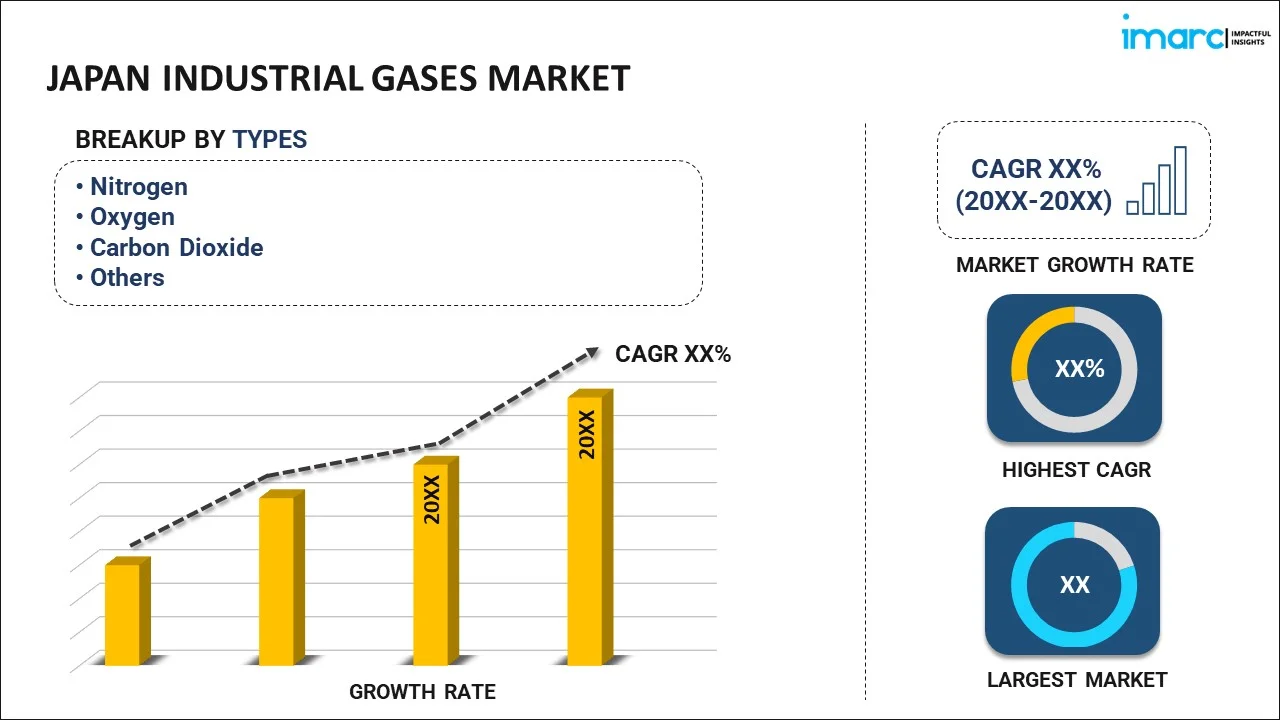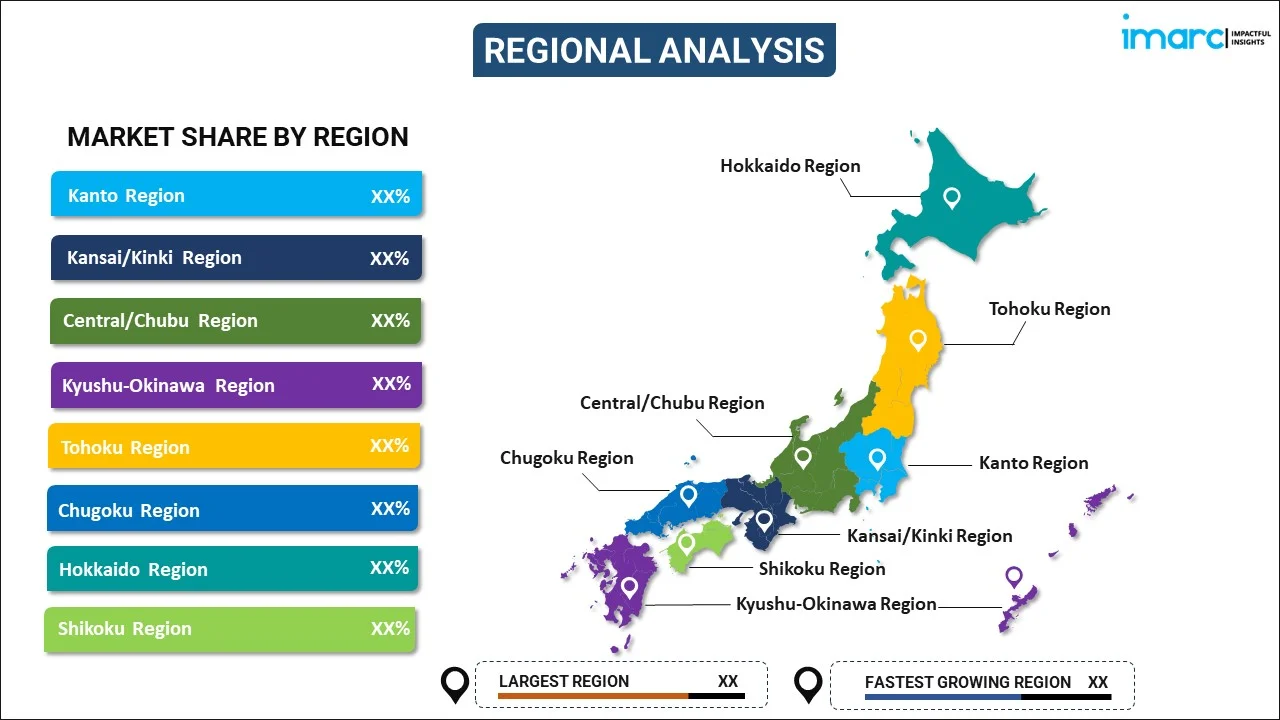
Japan Industrial Gases Market Report by Type (Nitrogen, Oxygen, Carbon Dioxide, Argon, Hydrogen, and Others), Application (Manufacturing, Metallurgy, Energy, Chemicals, Healthcare, and Others), Supply Mode (Packaged, Bulk, On-Site), and Region 2025-2033
Market Overview:
Japan industrial gases market size reached USD 3.8 Billion in 2024. Looking forward, IMARC Group expects the market to reach USD 5.4 Billion by 2033, exhibiting a growth rate (CAGR) of 3.5% during 2025-2033. The market is experiencing growth driven by several key factors, including the increased adoption of the product within the food and beverage (F&B) industry, its extensive use in manufacturing operations, and the recent advancements in on-site gas generation systems.
|
Report Attribute
|
Key Statistics
|
|---|---|
|
Base Year
|
2024
|
|
Forecast Years
|
2025-2033
|
|
Historical Years
|
2019-2024
|
| Market Size in 2024 | USD 3.8 Billion |
| Market Forecast in 2033 | USD 5.4 Billion |
| Market Growth Rate 2025-2033 | 3.5% |
Industrial gases are specialized, highly pure gases with unique properties that make them essential in various industrial applications. This category includes gases like oxygen, nitrogen, carbon dioxide, helium, argon, and hydrogen. They are produced commercially through several methods, including atmospheric separation, chemical reactions, and extraction from natural sources. Industrial gases find extensive use in diverse industries for activities such as combustion processes, metal fabrication, food packaging, electronics manufacturing, chemical production, drug formulation, and fuel extraction. They are considered safe, versatile, and environmentally friendly substances that offer cost savings, prevent spoilage, enhance product quality, and improve the overall efficiency of industrial processes.
Japan Industrial Gases Market Trends:
The industrial gases market in Japan is a dynamic and thriving sector characterized by substantial growth and innovation. Japan's industrial landscape, which encompasses a wide range of sectors such as manufacturing, electronics, chemicals, and healthcare, heavily relies on industrial gases for various critical processes. Gases like nitrogen, oxygen, and argon play pivotal roles in applications like metal fabrication, electronics manufacturing, and pharmaceutical production, driving the demand for high-purity gases. One of the defining features of Japan's industrial gases market is its commitment to technological advancement and environmental sustainability. The country places a strong emphasis on cutting-edge technologies and innovations in gas production, distribution, and utilization. Furthermore, Japan's dedication to reducing carbon emissions aligns perfectly with the adoption of eco-friendly industrial gas solutions, contributing to a greener and more sustainable industrial sector. The growth of on-site gas generation systems has also significantly impacted the market, offering industries greater control over their gas supply, increased efficiency, and reduced logistical complexities. Moreover, Japan's expanding healthcare sector has created new avenues for specialized gases used in medical applications, adding further impetus to the market's expansion. In summary, the Japan industrial gases market is characterized by robust growth, technological innovation, and a strong commitment to sustainability. With its diverse industrial base and continued investments in cutting-edge solutions, Japan is poised to remain a key player in the industrial gases market over the forecasted period.
Japan Industrial Gases Market Segmentation:
IMARC Group provides an analysis of the key trends in each segment of the market, along with forecasts at the country level for 2025-2033. Our report has categorized the market based on type, application, and supply mode.
Type Insights:

- Nitrogen
- Oxygen
- Carbon Dioxide
- Argon
- Hydrogen
- Others
The report has provided a detailed breakup and analysis of the market based on the type. This includes nitrogen, oxygen, carbon dioxide, argon, hydrogen, and others.
Application Insights:
- Manufacturing
- Metallurgy
- Energy
- Chemicals
- Healthcare
- Others
A detailed breakup and analysis of the market based on the application have also been provided in the report. This includes manufacturing, metallurgy, energy, chemicals, healthcare, and others.
Supply Mode Insights:
- Packaged
- Bulk
- On-Site
The report has provided a detailed breakup and analysis of the market based on the supply mode. This includes packaged, bulk, and on-site.
Regional Insights:

- Kanto Region
- Kansai/Kinki Region
- Central/ Chubu Region
- Kyushu-Okinawa Region
- Tohoku Region
- Chugoku Region
- Hokkaido Region
- Shikoku Region
The report has also provided a comprehensive analysis of all the major regional markets, which include Kanto Region, Kansai/Kinki Region, Central/ Chubu Region, Kyushu-Okinawa Region, Tohoku Region, Chugoku Region, Hokkaido Region, and Shikoku Region.
Competitive Landscape:
The market research report has also provided a comprehensive analysis of the competitive landscape. Competitive analysis such as market structure, key player positioning, top winning strategies, competitive dashboard, and company evaluation quadrant has been covered in the report. Also, detailed profiles of all major companies have been provided. Some of the key players include:
- Air Liquide Japan Ltd. (Air Liquide S.A)
- Air Water Inc.
- Iwatani Corporation
- Nippon Sanso Holdings Corporation
- Tokyo Gas Chemicals Co., Ltd.
(Please note that this is only a partial list of the key players, and the complete list is provided in the report.)
Japan Industrial Gases Market Report Coverage:
| Report Features | Details |
|---|---|
| Base Year of the Analysis | 2024 |
| Historical Period | 2019-2024 |
| Forecast Period | 2025-2033 |
| Units | Billion USD |
| Scope of the Report | Exploration of Historical Trends and Market Outlook, Industry Catalysts and Challenges, Segment-Wise Historical and Future Market Assessment:
|
| Types Covered | Nitrogen, Oxygen, Carbon Dioxide, Argon, Hydrogen, Others |
| Applications Covered | Manufacturing, Metallurgy, Energy, Chemicals, Healthcare, Others |
| Supply Modes Covered | Packaged, Bulk, On-Site |
| Regions Covered | Kanto Region, Kansai/Kinki Region, Central/ Chubu Region, Kyushu-Okinawa Region, Tohoku Region, Chugoku Region, Hokkaido Region, Shikoku Region |
| Companies Covered | Air Liquide Japan Ltd. (Air Liquide S.A), Air Water Inc., Iwatani Corporation, Nippon Sanso Holdings Corporation, Tokyo Gas Chemicals Co., Ltd., etc. |
| Customization Scope | 10% Free Customization |
| Post-Sale Analyst Support | 10-12 Weeks |
| Delivery Format | PDF and Excel through Email (We can also provide the editable version of the report in PPT/Word format on special request) |
Key Questions Answered in This Report:
- How has the Japan industrial gases market performed so far and how will it perform in the coming years?
- What has been the impact of COVID-19 on the Japan industrial gases market?
- What is the breakup of the Japan industrial gases market on the basis of type?
- What is the breakup of the Japan industrial gases market on the basis of application?
- What is the breakup of the Japan industrial gases market on the basis of supply mode?
- What are the various stages in the value chain of the Japan industrial gases market?
- What are the key driving factors and challenges in the Japan industrial gases?
- What is the structure of the Japan industrial gases market and who are the key players?
- What is the degree of competition in the Japan industrial gases market?
Key Benefits for Stakeholders:
- IMARC’s industry report offers a comprehensive quantitative analysis of various market segments, historical and current market trends, market forecasts, and dynamics of the Japan industrial gases market from 2019-2033.
- The research report provides the latest information on the market drivers, challenges, and opportunities in the Japan industrial gases market.
- Porter's five forces analysis assist stakeholders in assessing the impact of new entrants, competitive rivalry, supplier power, buyer power, and the threat of substitution. It helps stakeholders to analyze the level of competition within the Japan industrial gases industry and its attractiveness.
- Competitive landscape allows stakeholders to understand their competitive environment and provides an insight into the current positions of key players in the market.
Need more help?
- Speak to our experienced analysts for insights on the current market scenarios.
- Include additional segments and countries to customize the report as per your requirement.
- Gain an unparalleled competitive advantage in your domain by understanding how to utilize the report and positively impacting your operations and revenue.
- For further assistance, please connect with our analysts.
 Request Customization
Request Customization
 Speak to an Analyst
Speak to an Analyst
 Request Brochure
Request Brochure
 Inquire Before Buying
Inquire Before Buying




.webp)




.webp)












